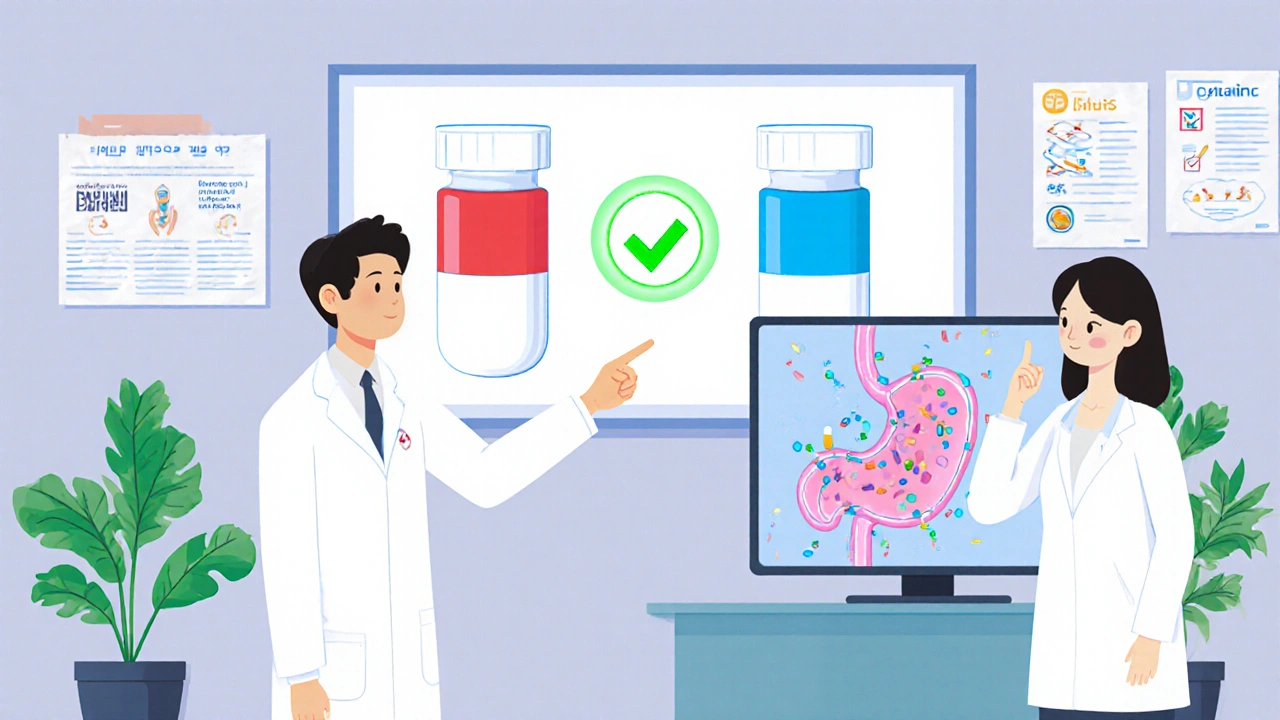
Most people don’t realize that over 90% of prescriptions filled in the U.S. are for generic drugs. Yet, many still hesitate to take them. Why? Because they’re confused. They see a pill that looks different. They hear rumors. They worry it’s not as good. That’s where infographics about generics come in - simple, clear pictures that explain what generics really are, and why they’re safe, effective, and often cheaper.
What Are Generic Drugs, Really?
A generic drug isn’t a copy. It’s not a knockoff. It’s the exact same medicine as the brand-name version - same active ingredient, same strength, same way it works in your body. The only differences? The shape, color, or filler ingredients. Those don’t affect how the drug treats your condition.
The U.S. Food and Drug Administration (FDA) requires every generic drug to prove it works the same way as the brand. This isn’t just paperwork. It’s science. Generics must match the brand’s bioequivalence - meaning they release the same amount of medicine into your bloodstream at the same speed. If they don’t, they don’t get approved.
Infographics like the FDA’s “What Makes a Generic the Same as a Brand-Name Drug?” show this with simple graphs. One side shows how the brand releases medicine over time. The other shows the generic. The lines overlap almost perfectly. That’s not marketing. That’s data. And 89% of patients who saw this graphic understood it right away.
Why Do People Still Doubt Generics?
It’s not about science. It’s about perception. A 2021 FDA survey found that 43% of patients worried generics weren’t as effective. Why? Because they’ve been told, directly or indirectly, that brand = better. TV ads, pharmacy shelves, even well-meaning doctors sometimes say “I’d take the brand myself” - even when the generic is identical.
Infographics tackle this head-on. They show side-by-side comparisons. They explain that the FDA inspects generic factories just like brand-name ones - sometimes even the same ones. They clarify that inactive ingredients (like dyes or binders) are harmless and don’t change how the drug works.
One common myth? That generics are made in shoddy labs overseas. The truth? The FDA inspects over 3,500 manufacturing sites worldwide - 50% of them in the U.S. and Europe. The same quality rules apply everywhere. A 2023 study in the Journal of Health Communication found that patients who saw infographics showing FDA inspection maps were 3.2 times more likely to trust generics than those who just got verbal explanations.
How Do These Infographics Work in Real Life?
At Kaiser Permanente’s clinics in Southern California, pharmacists started using FDA generic drug infographics in 2022. They kept printed copies behind the counter. They emailed them to patients after prescriptions. Within six months, patient refusals of generics dropped by 38%. One pharmacist said, “I’ve printed this and keep it behind the counter - cuts counseling time in half.”
It’s not just about saving time. It’s about reducing anxiety. A patient might see a white oval pill instead of the blue capsule they’re used to. They panic. “Is this the right medicine?” The infographic shows them: same active ingredient, same dose, same effect. No guesswork.
Hospitals, pharmacies, and community health centers now use these visuals in waiting rooms, on websites, and in digital patient portals. Epic Systems, the biggest electronic health record platform in the U.S., added FDA infographics to its patient education module in late 2022. In the first six months, over 450,000 patients viewed them.

Who Makes These Infographics - And What’s Different About Them?
The FDA leads the way. Their infographics are free, downloadable, and available in Spanish. They follow strict standards: 300 DPI resolution, CMYK color for printing, WCAG 2.1 AA accessibility for screen readers, and language tested to an 8th-grade reading level. Each one goes through patient testing - at least 30 people from different backgrounds - before it’s released.
The GTMRx Institute creates similar tools but focuses on how generics fit into full medication management. Their newer versions are interactive - you can plug in your meds and get a personalized breakdown of complexity, interactions, and cost savings.
BeMedWise offers patient-friendly guides too, but they only cover generics in 3 out of 15 of their core infographics. The FDA’s suite is far more complete. Their “Postmarketing Surveillance of Generic Drugs” infographic even shows how the FDA tracks side effects after drugs hit the market - proving generics are monitored just like brand-name ones.
But not all are equal. The FDA’s “Generic Drugs and Health Equity Handout” is the only one that addresses disparities. It points out that African American and Hispanic patients are more likely to doubt generics - not because they’re less informed, but because they’ve faced unequal care. That infographic doesn’t just explain science. It acknowledges history.
What’s Missing - And What’s Coming Next?
Even the best infographics have blind spots. Experts like Dr. Aaron Kesselheim from Harvard warn that some visuals oversimplify drugs with narrow therapeutic indexes - like warfarin or levothyroxine. Tiny changes in dose matter here. The current infographics don’t clearly show when a pharmacist must be notified before switching generics.
The Institute for Safe Medication Practices says this is a gap. They’re pushing for a new symbol - a small icon on the infographic that says “Pharmacist Alert” for these high-risk drugs.
Looking ahead, the FDA is testing augmented reality. Imagine scanning your pill bottle with your phone and seeing a 3D animation of how the generic and brand versions dissolve in your stomach. A prototype was shown at the 2023 Digital Health Innovation Summit. It’s not ready yet, but it’s coming.
By 2028, the Congressional Budget Office predicts generic use could hit 95% - if education keeps up. Right now, states with the highest generic use - like Oregon at 93% - also have the highest infographic downloads. That’s no accident.
How to Use These Tools - For Patients and Providers
If you’re a patient: Download the FDA’s “Facts About Generic Drugs” PDF. Print it. Keep it in your wallet or phone. Next time your pharmacist suggests a generic, pull it out. Ask: “Does this match what’s shown here?”
If you’re a provider: Add these to your patient portal. Share them during consultations. Use them in group education sessions. The FDA offers a free Stakeholder Toolkit with sample social media posts, posters, and a 15-minute training module. Over 12,000 healthcare workers have already taken it.
Don’t assume patients understand. Don’t assume they’ve heard the truth. A simple visual can turn fear into confidence. And confidence means better adherence - fewer missed doses, fewer hospital visits, lower costs.
The savings are real. From 2010 to 2019, generics saved the U.S. healthcare system $1.68 trillion. That’s not just numbers. That’s people who could afford their medicine. That’s lives improved.
Where to Find the Best Generic Drug Infographics
- FDA.gov/genericdrugs - Free, official, multilingual, and backed by science. Start here.
- GTMRx.org - Interactive tools for complex medication regimens.
- BeMedWise.org - Patient-focused guides, though less comprehensive on generics.
All are free. All are printable. All are designed to be understood - not just by doctors, but by people who just want to know if their medicine will work.
Are generic drugs really as good as brand-name drugs?
Yes. By law, the FDA requires generic drugs to have the same active ingredient, strength, dosage form, and route of administration as the brand-name version. They must also prove they work the same way in the body - releasing medicine at the same rate and amount. Over 90% of prescriptions in the U.S. are for generics, and they’re used safely every day by millions.
Why do generic pills look different?
The appearance - color, shape, size, or markings - is determined by the manufacturer and can’t be copied exactly to avoid trademark issues. But those differences don’t affect how the medicine works. The active ingredient, the dose, and how your body absorbs it are identical.
Are generic drugs made in unsafe factories?
No. The FDA inspects all manufacturing sites - whether for brand or generic drugs - before they can sell in the U.S. About half of these facilities are in the U.S. and Europe. The same strict standards apply everywhere. Many generic drugs are made in the same factories as brand-name versions.
Can I trust generics for serious conditions like heart disease or epilepsy?
Yes - with one important note. For drugs with a narrow therapeutic index - like warfarin, levothyroxine, or phenytoin - even small changes in blood levels matter. While generics are still approved as equivalent, some doctors prefer to stick with one brand or generic to avoid any variation. Always talk to your doctor or pharmacist if you’re unsure. The FDA’s infographics now include special notes for these cases.
Do generics cost less because they’re lower quality?
No. Generics cost less because they don’t need to repeat expensive clinical trials. The original brand paid to prove safety and effectiveness. Generics only need to prove they work the same way. That saves money - not quality. The FDA’s 2023 report showed generics saved $313 billion in the U.S. in just one year.
Can I ask my pharmacist to show me an infographic about my generic medication?
Absolutely. Pharmacists are encouraged to use visual tools like the FDA’s infographics during consultations. Many keep printed copies on hand. If yours doesn’t, ask if they can email or print one for you. It’s part of good patient care.
10 Comments
Write a comment
More Articles

Zithromax: Uses, Side Effects, Dosage, and Key Safety Tips
Zithromax, known as azithromycin, is a popular antibiotic used for various bacterial infections. This article covers what it treats, how it works, common side effects, real-world tips for use, and what to expect during treatment. Learn important safety information, how to take Zithromax for best results, and answers to questions people often ask before starting this medication.

Opioid Addiction and Trauma: Understanding the Unseen Link
Opioid addiction and trauma are often intertwined, with past emotional or physical pain contributing to dependency. This connection highlights the importance of addressing the underlying trauma in addiction treatment. Steps like trauma-informed care and personalized therapy can aid in recovery. Understanding this link is crucial for both individuals struggling with addiction and those supporting them.

Alpelisib: Frequently Asked Questions and Expert Answers
I recently explored the topic of Alpelisib, a medication used to treat advanced breast cancer, and gathered some frequently asked questions and expert answers. Alpelisib is specifically designed for patients with PIK3CA gene mutations, and it works by inhibiting the growth and spread of cancer cells. Experts recommend combining Alpelisib with hormone therapy for better results. Common side effects include high blood sugar levels, skin rash, and diarrhea, but these can be managed with appropriate care. If you or a loved one are considering Alpelisib, it's essential to consult with a healthcare professional to determine if it's the right treatment option.
Evelyn Salazar Garcia
November 30, 2025 AT 01:18Why do we even bother? Generics are just corporate scams dressed up as savings.